![]() THE LIFE OF ALEX AND BELLE PETERSON
THE LIFE OF ALEX AND BELLE PETERSON
as remembered by daughter Josephine (Gray)
Dad was born in Norway on June 10, 1899 and came to Canada with his parents in 1908. They came to Wetaskiwin where they stayed for two years, then moved to a homestead at Lea Park, just north of where Oscar Peterson now lives. Mother was born on August 19, 1900 in southern Alberta, before Alberta was a province, moving to Frog Lake with her parents, Mr. and Mrs. Dave Bristow, in 1910. Mom was 19 on the 19th of August, 1919, an item for "Believe it or Not" I always thought. My folks were married at Frog Lake in 1920.
Dad's schooling had started in Norway as he was nine years old when they came to Canada. In 1954 he made his first trip back to Norway and visited the school he had attended. It seemed to him he'd just been away for a holiday. Things were just as he remembered them. Education was a different story in Canada, as schools here were few and far between. Dad helped Grandpa Peterson build the Lea Park school, where he later finished his grade four at the age of sixteen. Mr. Gunder Brocke was the teacher at Lea Park at that time. Next he went to teach at St. Margaret's near Onion Lake, so Dad went there to stay with Mr. and Mrs. Brocke. He had skipped along to grade eight by this time and since grade eight pupils had to write departmental exams he and a fellow classmate, Eric Rotherham, had to go to Lloydminster to write them.
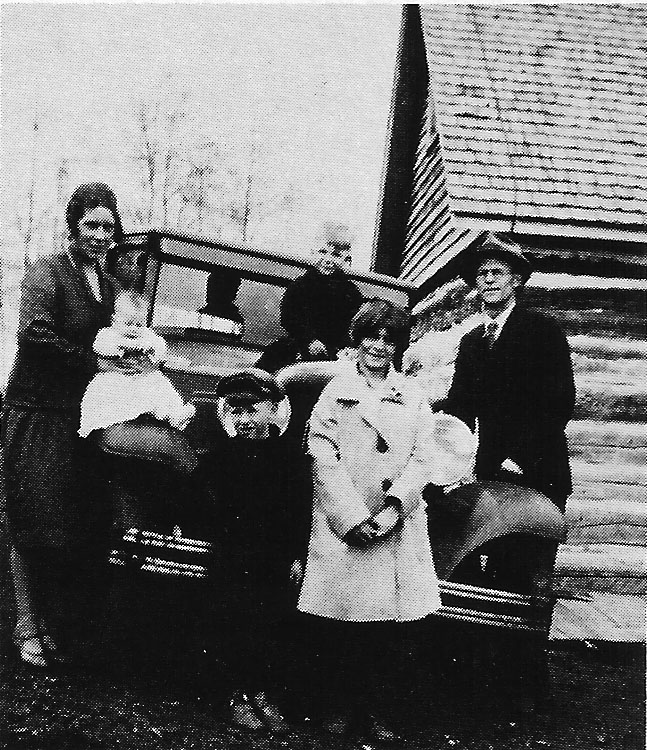
Belle, Phylllis, Dalton, Llewellyn, Josphine, Alex
I've often heard Dad tell the story of how they travelled that distance with a team of oxen, leaving at daylight and getting about half way the first day, sleeping under the wagon box at night, eating a dry lunch, and on again at daylight, getting to Lloydminster the second day. Apparently he passed his exams as he next went to Ryley with Brockes to take Grades nine and ten. He held Mr. Brocke in highest regard as he always helped and encouraged Dad to keep plugging for an education. Mr. Brocke was not only teacher and friend, but also music teacher. Dad took violin lessons from him as did so many of the children in the Lea Park district in later years.
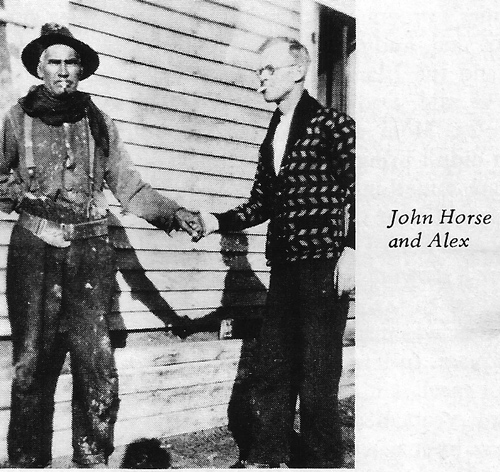
This all happened over a period of three years, as in 1918, when the flu epidemic hit, he was going to school at Strathcona High in Edmonton. When the school was forced to close he returned to Lea Park and helped the various farmers that were stricken with the flu. When the school reopened he had to walk from the Van Camp farm near Marwayne to Kitscoty, about thirteen miles through November rain and slush. He got to the station just in time to change his socks before the train got in. By the fall of 1919 Dad was back at Lea Park as teacher and taught on a permit here for three months.
On going through some of Dad's writings I came across this paragraph that probably sums up the hardships he endured to get his education. "On looking back I would say the hardest and toughest years of my life were those spent in High School. like all early homesteaders my parents were unable to help with my schooling so it was necessary for me to work out on farms from June to Christmas to earn enough money to put me through the balance of the year. With this handicap I had to work long and hard to catch up. Having lived all my life in the country I was naturally not acquainted with the ways of the city so I was sometimes referred to by an ignorant classmate as a 'hay seed.' Fortunately all the students weren't like him so I made friends then, and we've been friends to this day. Thankfully I passed all my exams in High School and went on to be a teacher."
After completing a short course for permit teachers at the Edmonton Normal School Dad came to Frog Lake where he taught for two years. Some of his pupils were: Millard and Sybil Kleinfelter; Alma, Ina and Marge Bowtell; Fred, Earl and Jean Granger; Eileen Bowtell, Frank Madvid, Clifford Upchurch, Harry Jenner; Myrtle and George McGowan; Beulah and Wayne Purdy; Nellie Bristow, Hazel and John Gardner.
The folks were married at Frog Lake while Dad taught there. They lived on SW 30-56-3-W4. Grandpa Peterson helped build a nice cottage on that farm. Dalton, Clarence, and myself were all born there. Llewellyn and Phyllis were born while we lived on the Frog Lake Reserve. Dad also taught the Norway Valley school for the term of 1923 and during this time we lived near where Mrs. Gudrun Barstad now lives. Some of the pupils that I recall him talking of are Ralph Lunden and some of the Gunderson children.
In this day and age when we take so many things for granted, school buses and modern schools among them, it seems very hard to visualize the hardships pioneer children endured to get a bit of schooling. Like Dad, Mother had many draw backs trying to get some education. She started school at Melrose in the Okotoks district, four miles south of DeWinton. Her sister Maggie, and some of her brothers were also going there. Miss Meehan was the teacher and school was open for a normal term. Mom has often told me about it, and I've seen pictures of the little girls wearing dark dresses with white pinafores, doubtless ones that had to be starched before ironing. On her first day of school Mom and her little friend were sitting in the first row, with sister Maggie in the back row - so, feeling a little lonely, these little girls got down and crawled on their tummies to the back where Maggie sat. Can you just imagine the color of the pinafores?
After a year of school Mom got scarlet fever and was quite ill; this together with the move to the north kept her out of school till she was twelve years old. She then went to stay with her cousin Jack Bristow in Vermilion. She had to start again in Grade 1 but managed to get through Grades 1, 2, and 3 from December to May that term. In 1912 the Bristow family moved to the Jack Johnson farm at Lea Park so the children could go to the Elgin school. They had a teacher there for three months of the year. When the Frog Lake school was built the family moved back and Mom went for one winter with Mr. Albin Varnum as teacher. In all, mother figures she had twenty seven months of school - not quite three terms by today's standards.
Dad started teaching the Indian school on the Frog Lake reserve in February 1924, and in the fall of 1925 we moved there. Our first home on the reserve was a log house; kitchen and living room downstairs and two bedrooms upstairs. As our family was growing up, myself and two brothers at this time, we needed more room, so in the fall of 1928 the old school that Mr. Charlie Quinney had taught in was moved about two miles and was put down next door to the old house. It took sixteen Indian horses to move this house. Some of the men that helped with the move were Billy Daniels, the carpenter, and Pierre Moyah. I am just sorry someone didn't think to take a picture of this big move! I don't think the structure of the building was damaged at all as it was a long, slow move. It took all day to move in from the main road - not even a half mile. A kitchen and bedroom were built on, the living room lined with plaster board, and all painted, making it very comfortable. We moved in the fall before my sister Phyllis was born. We lived there till we left in 1940.
Dad was hired as teacher by the Indian Department, but he also acted as Farm Instructor, on occasion doctor, sometimes preacher, and quite often peacemaker. One time the Archdeacon of the Anglican Church was going to visit and hold services at the school. One end of it could be changed to a church by just opening some doors, so a wedding was planned by one of die young couples. When the day came the bride got so shy she was ready to back out, but with Dad by her side she finally went down the aisle and took her vows. Sometimes there'd be family feuds in the night and either husband or wife would come for help. After a little talk and assurance that all would be well next day, they'd go home quite happy.
I don't just know what the wages were when Dad started to teach but before we left he got $105 per month, for the ten months of school, but only got a cheque every three months. With this wage our family of six lived well. We always had a car, getting a new one every three or four years. Mom made a lot of our clothes and ordered the rest out of the mail order catalogues. Oh, great day, when the parcel would arrive! We had one outfit for good, and one pair of overshoes lasted out the winter.
In January 1925 the folks got their first radio, a battery operated one with B and C dry cells and a battery like the car one that had to be charged. Uncle Peter was selling them for about $45 so we got one. It was one of the first in that part of the country so we had lots of company that winter. Folks dropped in to hear the boxing matches and especially the old time music from C.F.C.N. Calgary on Saturday night. Salt Lake City and Denver were two more stations that came in loud and clear, and on a cold night there'd be stations coming in right across the dial. The Indians were really baffled by this music box. They'd come inside and listen, then go back outside and gaze up at the aerial. You had to have one hundred feet of aerial wire on top of about a twenty foot pole for best reception. They just couldn't understand how the music came down that wire. One poor lady, Mrs. James Stanley, thought it was the voices of her dead children talking to her.
We really enjoyed the radio and I recall how it was the big deal to get the new batteries before the World Series Baseball games in the fall. Those batteries did us till next year, but of course the A battery had to be charged periodically. Some of the programs that stand out in my mind are: the Farmer's program for the kids, Fibber McGee and Molly, Amos and Andy, the Happy Gang, Lux Theatre, Don Messer and the Islanders, and of course, the soap operas.
As I've said, Dad was hired as teacher but filled many other roles. Mom also had her own duties. The Indian children didn't bring a noonday lunch so it was Mom's job to prepare something for them. At first there was a government issue of hard tack biscuits and each child got two or three plus a pot of tea. It doesn't sound like much of a lunch for a growing child but these biscuits were very tasty, and needless to say, nutritious; one kind was a plain white and another was made of whole wheat and were about four inches square. In later years they were provided with things for a hot meal at noon and Mom had to prepare this. Not too many years before the folks left the reserve, a club house was built where the present Protestant school stands. There, with the help of Mary Louise Horse and Alice Faithful, Mom formed a club for the women. They learned cooking, sewing and quilt making.
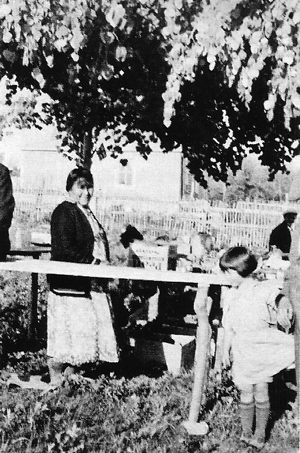
Alice Faithful in booth, Phyllis Peterson at corner
Alice Faithful and Eli Moyah were really true friends and could always be called on for help. Phyllis and Llewellyn didn't have to go away to school as Dalton and I did, so they were able to enjoy the freedom of early childhood - roaming the hills, looking for crocuses, birds nests, drowning out gophers in season, and invariably ending up at Alice and Eli's for a lunch. Alice made such good Bannock so the kids of course had to have the recipe:
One teaspoon baking powder
4 cups flour
1 teaspoon salt
1 cup milk - Cook in frying pan over slow coals.
Eli was our right hand man, helping with the gardening and keeping fires on if we were away in winter. I really felt badly when I heard of his death. Although we hadn't seen much of him in later years we remembered him as a very true friend and his passing brought us all sadness. We were always grateful to him for helping Mom save our buildings from a fire one dry spring. Dad had gone down to the Frog Lake store for the mail and had noticed this fire off to the east of the road, but didn't think it serious. Seemingly, the wind got up from the south and east, and the fire came creeping up on us from the south. Eli noticed the smoke getting pretty close so came over to warn us. Sure enough, the fire was almost to the barn! He, Mom and myself, with wet sacks, had to work hard and fast to keep the fire away from the barn and feed pen. If they had caught fire we wouldn't have been able to save our house. Just as we got things under control Dad got back with the mail and couldn't believe that the fire could have moved in that fast.
Prairie or forest fires, whatever one wished to call them, were a real menace in the spring and fall if conditions were dry. There was a particularly bad one in November of 1929. One evening just after supper the folks noticed a smoke to the north west. Since it was very dry with no snow, and the wind was in that direction, they kept watching it pretty close. Just about the folks' bed-time Dad decided to go for help, as the wind was strong and the fire was moving pretty fast in our direction. He went over to get Mom's brother and Mr. Granger, about an eight mile trip. By the time he got back the fire was just over the hill from our house, less than a quarter of a mile away. It was about ten in the evening by then and the wind had died down a bit. In the meantime Mom had got me up and dressed as she figured we'd have to take Dalton and Llewellyn (they were a lot smaller than me) and get out before Dad got back. I still have very vivid memories of that wall of fire moving in on us. It eventually burned itself out down by Frog Lake, a couple miles east of us, but it had destroyed all the Indians' hay stacks in its wake, and had burned sixteen horses so badly that most of them had to be destroyed. The Police from Onion Lake came out and disposed of them. Needless to say, lots of wildlife likewise lost their lives. Within three hours this fire had burned over ten miles and in some places, like swampy spots and willow clumps, it was still smouldering the next spring. I'm sure there were other fires but these two stand out so clearly in my mind. They were just too close for comfort.
Every other Saturday was ration day for the older folk and the ones that were sick. The rations were so many pounds of flour, side pork, a bit of tea, sometimes lard, and at one time fresh meat for all the Indian folk. They killed off a lot of the buffalo at Wainwright so each reserve got an allotment. In the fall sometimes there'd be woolen blankets for the older folks, and sometimes a few articles of clothing. We also had a supply of medicines on hand. I think it must have been more or less first-aid medicines, like aspirins, digestive upset pills, iodine, and red and white liniments.
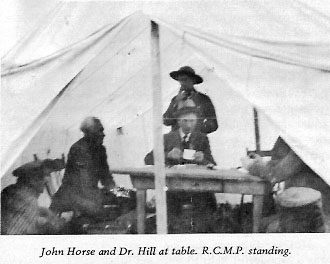
Treaty time was a great time for the Indian folk. For days they'd gather at said place and make camp, waiting for the big day. I'm sorry I can't remember more of the details and pageantry, but I do recall the Indian Agent (Mr. Turner, and then Dr. Hill), his clerk, an interpreter and the R.C.M.P. all coming from the Agency at Onion Lake. Then there would be the Chief and Councillors in their fine coats, from the Frog Lake band, joining the other officials in the pay tent. The Indians would then file in all day for their treaty money of $5 per person, with the Chief and Councillors getting a bit more.
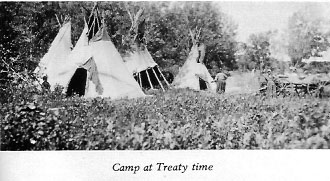
I do believe though that the highlight of the whole year, and especially the school year, was the Christmas concert. For weeks Dad would work to prepare the youngsters for it. For some of the beginners and the lower grades he made up a couple lines of poetry with the Christmas theme, and for the older ones there was a longer recitation. Of course there were the Christmas carols and the odd step dance. Dad played the violin and different ones would dance. Fred Fiddler was exceptionally good and he jigged to the tune of "Turkey-in-the Straw." There was always the decorated Christmas tree and Santa Claus, red suit and all. Long before he got to the door you could hear his bells and there'd be reports from Dad as to his nearness. The kids would be so excited and when Santa would get to the door he'd just peek in a few times, and wave to the people. By the time he finally made it in the audience would be in an uproar. He always tried to have a treat for each child; a bag of candy, nuts and fruit. Quite often, if the church groups from Edmonton had sent clothes and toys, these would be kept for Christmas gifts as well. Everyone liked the concert and long before dark the people would start coming. In spite of the weather there'd always be a crowd.
We always tried to keep the car running till Christmas time, depending on the amount of snow, as there was no such thing as a snow plow then. Even if it was quite cold Dad could usually get the car to go with a pan of hot coals under the oil pan, a warm battery and warm water for the radiator. Once the car quit running we depended on a horse and toboggan to get our mail and groceries. If there was something the whole family wanted to go to we'd borrow an Indian team and cutter. We'd heat rocks to keep our feet warm, pile on lots of quilts, and away we'd go. Sometimes it would be a long, slow trip as some of the horses didn't have too much "get up and go." We usually had a cow for milk and butter so we had to have a supply of hay. The Indians hauled this in for us at haying time for about $3 for a hayrack full. Our barn wasn't very big but there'd be times in the winter when it would be full and there'd be teams tied out by the hay stacks. These would be the fish freighters' teams. Our place seemed to be the right distance for a stop, both going to, and coming from Cold Lake. I've heard Mom say many times she'd get twenty-five cents for the night's lodging and maybe two meals. The Indians also got out our wood supply and after they had a huge pile of poles hauled in, we'd have a wood-sawing bee. There'd be lots of help, and the usual fun that a gang of men always had. After sawing came the splitting and piling of the blocks, and we'd have our year's supply of wood.
As I look back on those years of our life it is indeed with nostalgia. The Indian children Dad taught were very bright, especially in writing and art work. They weren't too healthy so the attendance wasn't good. However, the ones that came regularly went right along in school. Also, the friends we made among the grown-ups have been long-lasting friends. Those years on the reserve stand out in my mind as happy, carefree years. We lived comfortably according to the standards of that day. There was always time for a trip to town, a day's fishing or helping the neighbors - none of the hurry and scurry of to-day.
In the spring of 1932 the ladies of the white Frog Lake community formed a club, more or less as a fellowship group at first. When the community hall was built they worked to help support it. Mom helped form this club and I believe she was President for a number of years. Dad was representative on the Elk Point Hospital board for a long time and even tried a bit of politics, running on an Independent ticket in the spring of 1940. Mr. Berg of Marwayne was Social Credit candidate, and Mr. Chris Cairns was for C.C.F. Needless to say, Mr. Berg won the election.
We lived on the reserve till August of 1940 when Dad resigned as teacher to go into the Army. We lived in Heinsburg for a year, in Kitscoty for a year, and then moved to Saskatoon. Dad was stationed at Dundurn camp, just outside Saskatoon. He was with the Saskatchewan Light Horse Regiment as Pay Sergeant and was stationed in places from the west coast to Ottawa, the east coast and back to Dundurn. After the war the folks moved to Edmonton and bought the house where Mom still lives. For a time Dad worked as bookkeeper for coal mining companies at Robb and Wabamun.
In 1947 Dad was selling life insurance in these parts. Dick Hines said to him one time, "You'd better leave the country, Alex, as it's worth more dead than alive." He must have sold a lot of insurance as he earned an expense paid trip to Ontario for himself and Mom. He then worked with the Medical Service Insurance in its early years. From there he went to work with the Government in the Department of Lands and Forests, and was there till his retirement in 1964.
The folks enjoyed their retirement. They always had a lot of friends nearby and when these friends called there was always a cup of coffee, and invariably a game of two of cribbage. Dad was an ardent cribbage player. They always enjoyed camping at the lake, fishing, picking berries and an outing of any kind. The boys and their families live in Edmonton, as did Phyllis until this summer, when she and her husband moved to Victoria.
In 1954 Mom and Phyllis travelled through southern Europe on a conducted tour, then went on to Norway to meet Dad and visit relatives there. This was his first trip back to Norway but after his retirement he made two more. On one he took an extended trip into Russia. The folks celebrated their 50th anniversary in 1970 with open house in Greenlawn Hall. A large crowd of friends and relatives gathered for this, and later on another party was held for them at Fort Saskatchewan. Mom is still very active, keeping busy with her hobbies and gardening. She has always enjoyed knitting and sewing for the twelve grandchildren, and now, the five great grandchildren.
Until Dad's eyesight began to fail he enjoyed writing short stories and telling bits of history of the early days. It is regrettable that he didn't live long enough to write their story for this book. I have tried to tell, as I recalled them, some of the incidents in the lives of my parents, Alex and Belle Peterson, but doubtlessly I have overlooked a lot. However, anyone that is interested can hear a tape (No. 74.94, Reels 1, 2) at the Alberta Museum. This is a tape Dad finished just a few weeks before his passing in March of 1974.


